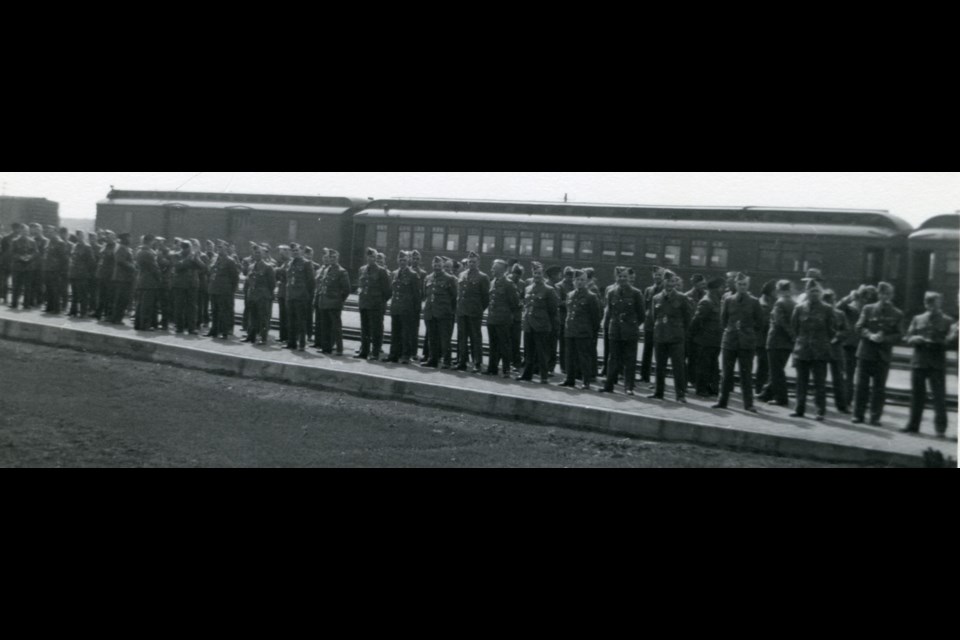MOOSE JAW — Moose Jaw held ceremonies on May 8, 1945, to mark the end of the Second World War in Europe, but these observances were not the “boisterous type” that marked the end of the First War.
Instead, as the Times-Herald reported, residents observed VE-Day as the end of a chapter — with a further horrible war still in progress against the Japanese that wouldn’t conclude until Sept. 2.
“Many residents remembered those who had gone away to fight and will never return,” the article said. “To others, it was a day of rejoicing that sons, daughters, fathers and brothers had come safely through the ordeal of battle and been spared to return to their homes.”
The day before VE-Day, residents decorated homes, downtown businesses and vehicles with flags and bunting, while many dogs wore red, white and blue colours on their collars.
One business, Cooling’s on –°¿∂ ”∆µ Hill, decorated its window with pictures of many young residents from that area who served their country.
Meanwhile, on the morning of VE-Day, many churches held services to commemorate the conflict’s conclusion. Many events included hymns, prayers, poems, Holy Communion, and even a sermon featuring a victory speech that a British general gave earlier that morning.
A solemn and religious undercurrent marked VE-Day in the afternoon, as thousands of residents gathered on Main Street to witness a parade and a public service of thanksgiving held later in the arena rink.
The parade included the Legion Air Cadet Band and long lines of marching men, including red-coated Mounties, veterans of the –°¿∂ ”∆µ African (Boer) War, the First Great War, and the Second Great War, a unit from Canada’s First Canadian Division that fought in Italy, other army divisions, and several army bands.
The procession included decorated floats, trucks and cars, and other paraphernalia that make up a celebratory parade. The march was led by “the indispensable Const. ‘Mickey’ Mackey and his motorcycle,” followed by cars carrying the mayor members of city council.
A parade entry that attracted much attention were three Russian Cossacks in uniform, mounted on fiery steeds that, at times, called for expert horsemanship to control, the article said.
This “colourful pageant” moved up Main Street, turned onto Ross Street and into the arena, with citizens pouring into the building until it was packed “in a manner reminiscent of the old Miller hockey games,” the report continued.
Legion president H.R. Nickelson led the –°¿∂ ”∆µ, which was quiet and religious and, compared to the “rampant war-end hysteria” that swept through Canada and the rest of the world, was “singularly absent” from city streets that day.
Mayor J. Fraser McClellan gave a brief address and honoured all in uniform and thanked God for the “unflinching men in battle” and the great war leaders. Every time he mentioned names, the crowd cheered and whistled in support.
“Now left,” the mayor added, “is the joy of looking forward to reunion with loved ones who will be returning home from battle.”
There were prayers, hymns, a minute of silence for the fallen, a prayer for remembrance, and more hymns. Afterward, many people marched to the memorial cross in Crescent Park, where two servicemen placed a wreath to remember the fallen. The crowd stood “hushed in silence” as the bugle sounded The Last Post and Reveille.
A highlight of the parade was that 27 original members of the 77th Battery, Royal Canadian Artillery, who were from Moose Jaw and had just returned from overseas service, were permitted to attend the VE Day observance.
A celebration was held that night at the armoury, with residents packing every inch of the building following the arrival of military personnel from the mile-long parade “that probably surpassed anything of its kind attempted in the city before,” the article said.
Organizers were forced to change the program because the “tremendous crowd” hampered maintaining a proper schedule. Yet, the program continued, and people were gripped by the Sea Cadets raising the Canadian flag, while the singing of O Canada “was a striking reflection of the sentiments and feelings of those present.”
A pageant and dedication service followed the main –°¿∂ ”∆µ, with numerous community groups, students, schools and military personnel supporting these efforts.
“The fireworks display that followed on the racecourse enclosure was a great treat for the younger generation, to many of whom it was something entirely new, for fireworks in Canada during the five years and more of war have been few and far between,” the article said.
The evening then closed with a dance at the armoury that went “until a late hour.”
This is part 3 of 4 in a series.




